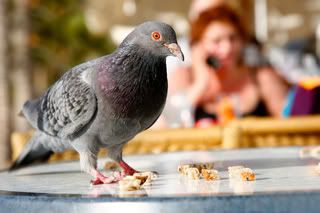 If your school is like most, it has open courtyards, outdoor eating areas and overflowing garbage cans and dumpsters. Birds love to loiter around these areas and seek out any food scraps left under lunch tables and benches. And when they see an opportunity, they’ll dive in. After they’re stuffed, they’ll “let loose” some sizeable bird droppings. These droppings can end up on playgrounds, water faucets, lunch benches, tables and walkways. Besides being unsightly, bird droppings can carry any of 60 know diseases, including salmonella and ecoli. Children can also slip and fall on fresh bird droppings, a liability for any school district.
Chances are, you’ve put up with pest birds all year long. Fortunately, there are three simple things you can do to keep them away. And there’s no better time to implement these effective bird control solutions than during the holiday break. So act now while maintenance crews are on site to keep bird pests from flocking to your school.
Scare Birds Away with Repeller 360°
This simple bird control device sweeps pest birds off rooftops, AC units and other flat areas using sustainable wind power. Ideal for keeping larger birds like pigeons, crows, gulls, cormorants and raptors from landing, Bird-B-Gone’s Repeller 360°’s two long arms each have end sails covered with reflective “predator eyes.” When the arms spin in the breeze, the sweeping action and predator eyes combine to make an effective pest bird deterrent. Self-sufficient and easy to set up, the Repeller 360° needs no electrical power or wiring. It rotates continuously in the wind, covering a 6-foot diameter to harmlessly convince bird pests to move on.
Pest Birds Hate Bird Jolt Flat Track
Give pest birds a lesson they’ll never forget—a “hello” jolt of electricity when they land on your school roof, ledge or sign. Bird-B-Gone’s Bird Jolt Flat Track “educates” birds but won’t harm them. It’s like getting a shock when you touch a doorknob after walking on the carpet. The shock convinces birds to avoid any lofty areas of your school. Bird Jolt Flat Track is the #1 Specified electric track by architects and government agencies. Its patented “anti-arcing” design provides an added level of safety. It’s also crush proof and will continue to work even if stepped on by window washers or building maintenance crews.
Bird Spikes Create No-Landing Zone for Bird Pests
Whether you choose plastic or stainless steel, Bird-B-Gone Bird Spikes simply won’t allow birds to land or perch on or near them. Steel bird spikes feature rows of stainless steel spikes embedded in a U.V.-protected polycarbonate base. You can also go with Plastic Bird Spikes, which come in white, tan, gray, black, brown, brick red and crystal clear--to blend in with your school’s color scheme. Plastic spikes are made of rigid U.V.-resistant unbreakable polycarbonate, which makes them tough and economical. Neither type of bird spike will harm birds or installation crews.

by Alex A. Kecskes
If you have pest birds hanging around your pool, you know the problems they cause. They leave droppings everywhere, which means frequent (and expensive) pool cleanings and constant hosing down of walkways, railings and steps. If you live in Southern California, ducks can be a big problem around pools. So can pigeons and grackles.
Sometimes birds clean out their nests and drop their waste in and around a pool. They often do this to avoid drawing predators to their nests. Black birds will sometimes spit in a pool. Some homeowners have resorted to poisons and BB guns. Not a good idea if you have pets or kids around (it’s also illegal to kill or harm certain birds). Others have taken to placing rubber snakes around the pool. These can be initially traumatizing to small children, and some pets have a tendency to chew and eat them. There are effective bird control devices you can use that will keep pest birds away from your pool without risking danger to people, kids, birds or pets. They include:
Bird Sonics. Mounted under eaves, patio covers or gazebos, these bird repellent devices can keep pest birds away from your pool or spa. Bird sonics emit predator and distress calls that birds instinctively fee from. They work on a bird's natural fear of predators, as well as their acutely sensitive hearing (birds can process sounds in 1/200th of a second; humans process sounds in 1/20th of a second).
Sonic bird deterrents work well against pigeons, crows, starlings, swallows, gulls, woodpeckers, sparrows, grackles, cormorants and many other species. One commercially available sonic system blasts the sound of Peregrine falcons (a pigeon's dreaded enemy) defending their territory. Another system targets starlings and seagulls, emitting the sounds of predator hawk screeching and gulls under attack. The best sonic systems will regularly alter the pitch, frequency, timing and intensity of their sounds. This keeps pest birds from getting used to repetitive sounds. One popular system can emit distress and predator calls for as many as 22 types of birds. The calls are repeated once every fifteen minutes. Sonic bird deterrents are not harmful to birds, pets or humans. The sounds they emit merely resemble normal bird sounds.
Visual Scare Deterrents. These include Bird Scare Balloons, flash tape and twine. The balloons feature large predator eyes that make birds really nervous. Scare Bird Diverters use the same principle. They feature a giant predator eye and can be hung under eaves to frighten birds. To keep birds, geese and ducks away from pools, fill bird scare balloons one-fourth full of water, and the rest with air. The balloons will float around the pool with predator eyes and shiny reflective surfaces constantly in motion to keep birds away. When using visual scare devices, it’s important to move them around occasionally to prevent swallows from getting used to them.
Scarecrows. Any pest birds that approach this device’s radius of protection get hit with a stunning but harmless blast of water. The sudden water blast, alarming sprinkler sound and realistic looking bird-like moving head "persuade" birds to stay away. Scarecrows are simple to set up and easy to use. They connect to almost any garden hose, yet they consume just 2 to 3 cups of water per spray. Scarecrows cover approximately 1,200 square feet with a stream that reaches out 35 feet and 45 feet wide. They work day and night for up to 6 months and deliver over 1,000 "firings" on a single 9-volt battery. For added versatility, scarecrows can be easily fine tuned to adjust both their sensitivity and coverage distance. Incidentally, kids and dogs love to play with these devices.
Mini Scarecrow. For smaller applications, say to keep pest birds away from walkways, pool steps, diving boards or railings, there's the Mini Scarecrow. It uses compressed air and sound to scatter pest birds and "convince" them to avoid the area. Like its big brother, the Mini comes to life the second a pest bird gets within 3 to 4 feet of its sensor. Unlike its larger brother, the Mini hits birds with a squeal and a harmless blast of air. You can easily adjust Mini's angle of detection and spray angle to zero in on trouble spots. Each can holds over 200 sprays.

by Alex A. Kecskes
Let’s say you own or manage an open-air produce market, the kind that’s becoming increasingly popular as today’s quality conscious consumers shy away from big chain supermarkets.
You pride yourself on the fresh, clean appearance of your store, something that draws a discriminating clientele to shop there, week after week. What you don’t want to draw are pest birds. They not only bother your customers, but they can ruin the image of your store with their smelly nests and droppings. Droppings that can contaminate your produce, deface your signage and awnings/umbrellas, and create filthy walkways your customers will sidestep to avoid. Worse yet, bird droppings on open-air produce can bring a citation or two from health inspectors who can easily shut you down.
So how do you get rid of pest birds? BB guns, poisons, noisemakers--they’re just too dangerous or intrusive to be practical. The only viable solution is modern effective bird control. These devices and systems have been specifically designed to deter pest birds from commercial premises like yours. Here are a few of the more popular pest bird deterrents:
Bird Spike. Pest birds love to loiter on roofs, parapet walls, signage, awnings and other lofty areas. From there, they can “dive bomb” onto open food carts and displays, pick food off tables and chairs, and scavenge for scraps on the ground. Bird spikes deny them these loft perches, making it impossible for birds to land on or near them. Ideal for pigeons, crows and other large birds, bird spikes come in strong, rigid unbreakable polycarbonate or flexible stainless steel. The best spikes are made of marine-grade stainless steel and feature a U.V.-protected polycarbonate base. You can also get bird spikes with a crush proof, non-reflective metal finish. If you opt for less expensive plastic bird spikes, you can choose from a variety of colors--like white, tan, gray, black, brown, brick red and crystal clear. To keep birds like crows and pigeons out of your rain gutters, you’ll need the Gutter Spike, which has an adjustable clamp at the base for easy attachment to the lip of a gutter.
Bird Spider. To protect specific areas of your market from pest birds, Bird Spiders can be quite effective. These portable devices can be easily moved onto most lofty areas birds like to frequent. They include a glue-on base, which allows them to be permanently affixed to flat most surfaces. Place one or two on a roof or fixed awning and birds will definitely avoid the area. How do they work? Simple. Bird spiders use long spindly spider-like arms that whip about in the breeze, making pest birds too nervous to land near them. If your market has outdoor seating areas, you can temporarily place a spider on an outdoor table or two before opening hours to keep pest birds from landing on them. Spiders come in several diameters (arm lengths) to discourage many types of pest birds--typically, 2-, 4- and 8-foot arms to cover increasingly larger areas. Ideal for use against pigeons, seagulls and larger birds, spiders have no moving parts to wear out, so they’re basically maintenance free. Look for bird spiders that have a U.V.-protected polycarbonate base.
Bird Sonics. Certain sounds can be perfectly innocuous to humans while at the same time striking fear in the hearts of pest birds. Bird sonic systems have been scientifically designed by ornithologists to do just that. These systems and their portable speakers are easily mounted on storefronts, patio covers, and under eaves and awnings. They can keep pest birds away from outdoor areas by emitting predator and distress calls most birds find alarming and disturbing. Once installed, they’re designed to ward off all manner of birds--including pigeons, crows, starlings, swallows, gulls, woodpeckers, sparrows, grackles, cormorants and many others. One super-flexible sonic system emits distress and predator calls for 22 types of birds. Something to keep in mind if you’re being invaded by several bird species.
|



 RSS Feed
RSS Feed